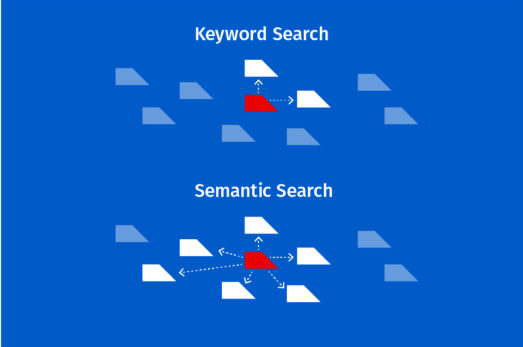In our digital age, where information is abundant and diverse, traditional keyword-based search engines can sometimes leave users feeling frustrated with irrelevant results that only match exact keywords and phrases.
Fortunately, semantic search is here to revolutionize the way we search for information online. This cutting-edge technology goes beyond the limitations of keyword matching by taking a query’s context and intent into account.
Semantic search can understand the underlying meaning of words and identify related words and images. For example, a semantic search could help associate text about a crane with a picture of a construction crane, whereas searching for an image of the word crane would give you both the animal and the construction equipment.
Let’s explore why semantic search is important, how it works and who stands to benefit from its capabilities.
Why is semantic search important?
There are several ways that semantic search improves the search process, including:
-
- Traditional search engines rely heavily on exact keyword matches, often leading to inaccurate or irrelevant results. Semantic search considers the context and intent behind each query. This provides a deeper understanding of your needs and delivers results that are more in line with your intentions.
- With semantic search, you no longer need to think in terms of keywords. You can express your queries in natural language, just as you would when speaking to a person, and still get highly relevant results.
- Semantic search can extract meaningful information from structured and unstructured data sources, including text, images and videos. This capability makes it easier to find relevant information from a wide variety of content types, enhancing the overall search experience.
How is semantic search unique?
Here is a visualization for embeddings in the space that is used for semantic search:

Scientists have been on a quest to unveil the hidden structure of each word’s meaning. For example, what we now refer to as “word vectors” or “vector-space models” serve as the fundamental building blocks for semantic vector search.
What makes these models so intriguing is their ability to quantitatively represent the rich meaning that each word carries. Despite differences in their underlying formulations, the models share a common mission: To depict the intricate web of semantic relationships between words in a high-dimensional geometric space.
This space is a mathematical playground where each word is represented as a vector, and words that share similar meanings gravitate towards one another. Their proximity in this semantic space is often measured using the cosine similarity, a mathematical tool that gauges how closely the vectors align.
In short, these word vectors are like compasses guiding us through the vast landscape of human language. They allow us to navigate the intricacies of meaning, unlocking doors to applications like natural language processing, machine translation and information retrieval.
How does semantic search work?
Here are some basic definitions regarding how semantic search works:
Semantic search: Employs machine learning and natural language processing techniques to index and categorize content based on concepts, entities and their relationships. This segmentation during information storage delivers more nuanced search results.
Semantic search also examines the individual words in your query and the context in which they are presented. This analysis helps decipher your intent, resulting in more precise and accurate search results.
Some semantic search systems use knowledge graphs, which are interconnected databases of structured information, to enhance their understanding of the relationships between concepts and entities.
Entity recognition: Identifies and comprehends entities, such as people, places and organizations, within your query and matches them with relevant information in the indexed content.
Latent semantic analysis (LSA): It’s often employed to identify relationships between words and concepts, enabling a search engine to retrieve relevant content even if it doesn’t contain the exact query keywords.
Who benefits from semantic search?
Semantic search has wide-ranging applications, and several groups can benefit from its capabilities, including:
- E-commerce and search companies: Almost every e-commerce interaction begins with a search. Semantic search enhances users’ experience by ensuring that customers find what they’re looking for quickly and accurately, leading to increased sales and customer satisfaction.
- Businesses and content providers: Internal optimization of content is crucial for businesses and content providers looking to improve their visibility online. Semantic search helps them ensure that their content is discoverable by people who are seeking their products or services online.
- Researchers and academics: Semantic search aids both groups in accessing relevant literature and information for their work. It streamlines the process of gathering data and conducting research, ultimately, advancing fields of study.
Whether you’re a business owner, a customer, a researcher or simply a curious internet user, semantic search is poised to make your online experience more efficient and rewarding.